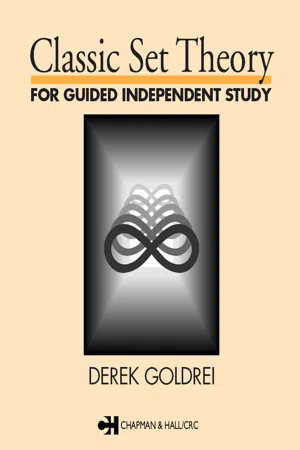1.1 Outline of the book
The language of sets is part of the vocabulary of any student or user of mathematics, acquired very early in one’s schooling. Words like ‘intersection’ and ‘union’ have become part of everyday mathematics. But the ‘set theory’ in this book is about much deeper and more complicated ideas about sets, at the heart of any discussion of the foundations of mathematics, especially about the place of ‘infinity’ in the subject. Many of these deep ideas have their origin in the work of Georg Cantor, a German mathematician at his most active in the latter half of the 19th-century. Cantor had many remarkable (and controversial) insights to the nature of infinity, producing a theory involving two sorts of ‘infinite number’, each equipped with an arithmetic incorporating and extending the familiar arithmetic of the natural numbers. Among the questions which he was able to pose and resolve were such as:
Are there more rational numbers than natural numbers?
Are there more irrational real numbers than rational numbers?
Are there more points in the real plane than on the real line?
For a very accessible account of Cantor’s life (1845-1918) and work, look at the biography by Dauben [7]·
In set theory it is customary to use ‘natural number’ to mean a non-negative integer.
The obvious answer to the first of these questions is probably ‘Yes’, on the grounds that the set of natural numbers is a proper subset of the set of rational numbers – we make no apologies for leaping into use of the everyday language of sets! The obvious answer to the third question might similarly seem to be ‘Yes’. In both cases, Cantor’s answer was in fact ‘No’, and one aim of this book is to explain his reasons why.
However, if you are unhappy with some of the set terminology, don’t worry! We shall explain it more carefully later on.
Cantor’s answer is ‘Yes’.
There might not be such an obvious candidate for the answer to the second question above – it all depends on how much you already know about the real numbers. Another aim of this book is to give an explanation of what the real numbers axe, another aspect of Cantor’s work, and part of the work of his contemporary Richard Dedekind (1831-1916). This explanation leads to the need to explain even more basic numbers, namely the natural numbers.
Cantor’s work on infinity really stemmed from his and others’ work on real analysis, and there are several connections between the issues of infinity and of the real numbers. First there was the drive in the 19th century to put the calculus onto a rigorous footing, giving what is now taught as real analysis: the last stage of this required a firm algebraic description of the reals, while earlier stages needed to explain away or eliminate uses of infinity, e.g. the infinitely large, like the ∞ in , and the infinitely small, namely infinitesimals. Secondly the descriptions of the reals provided by Dedekind and Cantor required the overt handling, as legitimate mathematical objects, of infinite sets. And thirdly mathematical developments in real analysis led to the desire both to study infinite subsets of the real numbers and to carry out infinite processes on such subsets.
Infinitesimals, infinitely small quantities, played a major part in the theory of calculus, until banished through the work of Weierstrass and others in the mid-19th century. Twentieth-century logic, inspired in part by Cantor’s work, has resurrected infinitesimals within the context of non-standard analysis.
The key issue is whether it is legitimate to treat an infinite set as a mathematical object which one can then use in further constructions. We are so used, in the final years of the 20th century, not only to writing and talking about infinite sets like the set ℕ of natural numbers and the set ℝ of real numbers, but also to manipulating such sets using e.g. operations like intersection (∩) and union (∪), that it is easy to forget, or be unaware of, how controversial the use of infinite sets was until (and perhaps still after) Cantor’s work. Mathematicians had been happy to regard, say, the natural numbers as being potentially infinite, meaning that however (finitely) many numbers one might list, there would always be an extra one that could be added to the list; but they were wary of treating this list as though it could be completed to give a single infinite object, what would be described as an actually infinite object. This rejection was very deeply rooted, going back to the work of Aristotle in the 4th century BC. Of course, over the same period there had been much discussion, and use, of both infinitely small quantities and what looked suspiciously like infinite processes (the dots ..’ in so many mathematical expressions), that some sort of resolution of infinity was due. This resolution was essentially done by Cantor.
Both the history and philosophy are well described in the books by Adrian Moore [8] and Lavine [9]. Some of the pre-1900 mathematical source material on infinity and the calculus can be found in Fauvel and Gray [10].
Cantor’s work, by virtue of its revolutionary nature, raised very many difficult and worrying issues. Matters were not helped by the initial imprecision of som...
